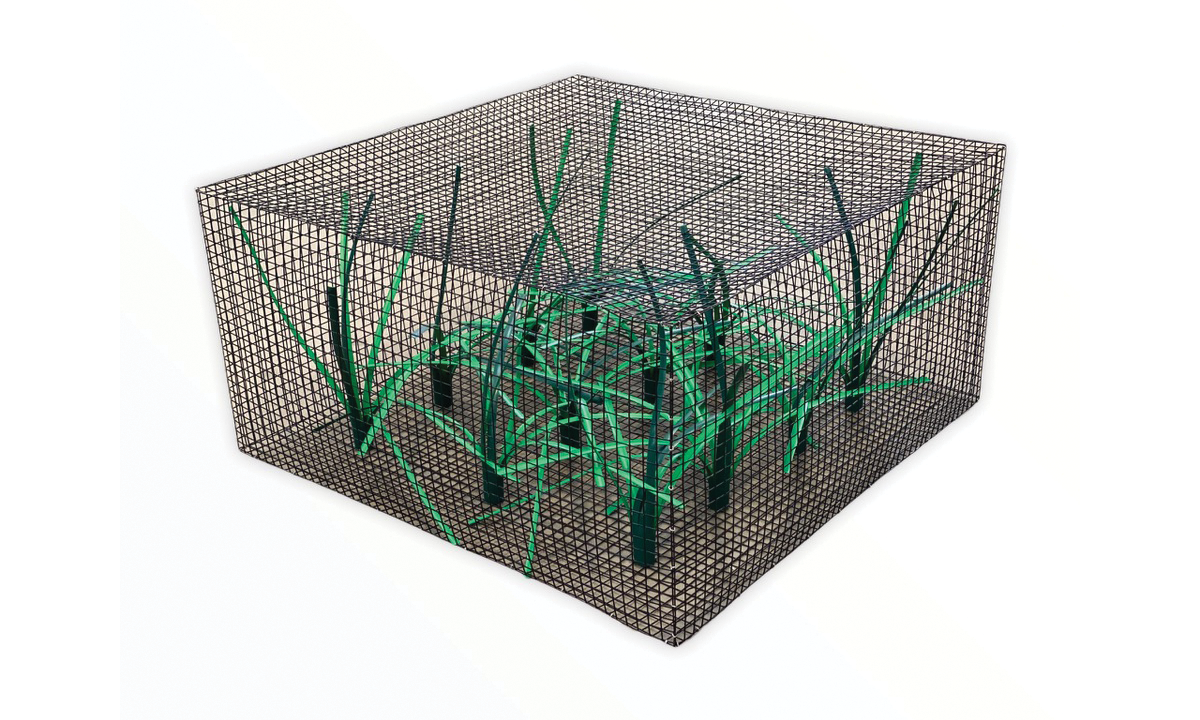Specifications
Water Depth
4 to 5 ft.
4 to 5 ft.
Volume
32 cubic ft.
32 cubic ft.
Height
2'
2'
Footprint
4'x4'
4'x4'
Weight
30 lbs.
30 lbs.
Leaf Limb Count
96 leaves/12 limbs
96 leaves/12 limbs
Life Stage
Fry
Fry
More Details
Each Honey Hole Mega Nursery comes with these standard features:
- (1) Mesh Enclosure
- (12) 24 in. Honey Hole Reed Limbs
- (1) Marker Float & Rope
When you order artificial fish habitat online, it will be shipped to you via ground and the fees are calculated at checkout. Typically, it takes less than a week for us to process your order for shipping from our facility in Lindsay, Texas. When it does, you’ll receive a confirmation email including your tracking number.
All of Pond King’s artificial fish habitat carries a 1 year limited warranty on any manufacturer defects. While we stand behind our products, we aren't obligated to replace parts that are misused (eaten by otters, beavers, snapping turtles, stolen or tampered with) or damaged due to normal wear and tear. But we love a good story so if any of the above applies to you, shoot us an email (with pictures, please) to let us know what happened.
FAQ
Fish need cover. They either go to it to feed, or they go to it to avoid being eaten. Submerged vegetation is valuable as habitat for predatory species like Bass or Crappie and for forage species like Bluegill. Pond King’s fisheries biologists designed the Honey Hole product line to augment or replace naturally occurring aquatic vegetation to attract game fish (the fish that use cover as ambush to help them feed) and protect forage fish (the species that use habitat to hide from predation).
Our artificial fish habitat is designed for pond and lake owners to help with fish population management without a lot of vegetation control. Natural vegetation can be difficult to control for two primary reasons; Vegetation can take over the environment, Structure can, and almost always does, decay. For those reasons, it’s not always easy to manage naturally occurring habitat. Our fish habitat is intended to provide an effective and affordable alternative to natural cover types for a variety of purposes and objectives. All of Pond King’s artificial fish habitat is safe for the environment, reduces the likelihood of snagged lures, is easy to assemble and deploy, doesn’t decay, and you can find it using your fish finder, so locating your honey hole season after season is a snap.
The Honey Hole Reeds and Dock Dropper ship fully assembled. The other Honey Hole products require some minimal assembly, which can easily be done in your shop or at your pond, but never with any toxic glues!
Absolutely not! The Honey Hole Tower as well as the Honey Hole Brush, Shrub, Tree, Grass Beds and Reeds can just be tossed into the water from your boat or the shore. You just drop the Dock Dropper from your dock (as the name implies), secure it to your deck and you are good to go.
Pond King’s Honey Hole artificial fish habitat is made of High Density Polyethylene (HDPE) and is designed to be assembled without any toxic glues or adhesives, so yes it is safe for the environment. In fact, given that it doesn’t degrade overtime and minimizes the number of lures snagged that land on the bottom of the lake or pond, some might even say our artificial fish habitat is good for the environment!
Our artificial fish habitat has a higher-than average limb count which results in a lot more surface area for the accumulation of periphyton. Plus, the materials we use to make our habitat are biologically inert, so they aren't just safe for your pond today, they are safe for the life of the product.
| Honey Hole Products | Other Artificial Fish Habitat |
|
|
|
|
|
|
|
|
This Artificial Fish Habitat At-a-Glance chart shows the ideal depth and placement for each type of artificial fish habitat. If you still have questions, give us a call at (940) 305-0490 and our fisheries biologist can help you decide.
★★★★★
All Reviews
It was very easy to put together given its large size & I am excited to see how this will help my newly dug pond.
Kavin M., Verified Customer

Habitat designed to provide cover from predation
At this life-stage, the number one reason fish need cover is to survive. The Honey Hole Mega Nursery provides 32-cubic feet of nearly 100% escape cover for newly hatched fry. This volume of coverage greatly increases the survival rates of your forage species, reducing the need for supplemental stockings. As predators approach, the fry are able to move quickly and safely through the mesh and continue feeding without interruption. This allows them to survive the first critical weeks of life where typically 98% of most fry are consumed.
Artificial habitat that produces an important food source
The Mega Nursery has 12 Honey Hole Reed stems for a total of 96 “leaves” contained within the mesh enclosure. The large number of grass stems quickly accumulate periphyton, which the fry eat. So, not only are they protected from predation, they are able to consume healthy nutrients which help them grow to the next life stage.


Long-lasting and environmentally friendly
Like all of our artificial fish habitat, the Nursery is made from High Density Polyethylene (HDPE) - which is biologically inert and is the same material the FDA has approved for food storage. The wire mesh is coated to prevent decay. And, since we don’t use any glues or adhesives, you don’t have to worry about the Nursery off-gassing toxins over-time.










